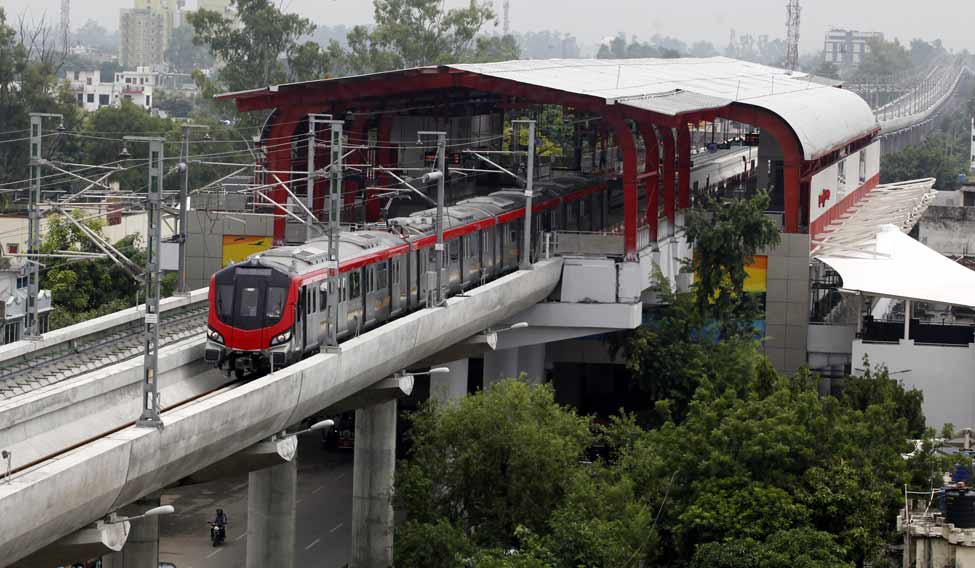The city of Nawabs is in an upbeat mood as it celebrates the journey of the Lucknow metro rail, which is all set to begin its commercial run today.
Union Home Minister Rajnath Singh and chief minister Yogi Adityanath will formally inaugurate the metro today in the presence of other political dignitaries. Operations along the ‘priority corridor’—from Transport Nagar to Charbagh railway station, covering a stretch of 8.5 kms—will commence from tomorrow. The route has eight stations—Transport Nagar, Krishna Nagar, Singar Nagar, Alambagh, Bus Station, Durgapuri, Mawaiya and Charbagh Railway Station.
With this, Lucknowites' long wait for a hassle-free, fast travel is becoming a reality. “The metro launch would bring a change in the lifestyle of the city. It would give impetus to the city for progress and change the thinking process of individuals,” said metroman E. Sreedharan, who is also the principal adviser to the Lucknow Metro Rail Corporation (LMRC), a 50:50 joint-venture of UP and central governments that developed the project.
The total cost of phase-one and -two of the project is estimated to be around $2 billion (around Rs 13,800 crore). Interestingly, Lucknow Metro has a big feather in its cap—it is the maiden project in the entire country to start operations within a period of three years after commencement of work.
Once fully operational, the metro will run on two lines—the north-south line and the east-west line. The north-south corridor begins near Chaudhary Charan Singh Airport and will end at Munshi Pulia, covering a total distance of 22.8 kms. The east-west corridor starts at Charbagh Railway Station and will end at Gomtinagar.
Time gap between two consecutive trains will be around five to seven minutes, considerably reducing the waiting time for commuters who are used to travel by traditional means of public transport such as buses, autos and e-rickshaws till date. The metro stations will also have reverse clocks that will provide information about the estimated time of the train’s arrival.
“About 1.5 lakh commuters travel daily through the priority corridor, along with 70,000 private vehicles and 600 three-wheelers. Metro will reduce this burden considerably,” said Pankaj Dixit, head of Lucknow Auto Rickshaw Three-Wheelers' Sangh.
Commuters will also have smart metro stations equipped with add-value machines (AVMs), which will allow passengers to validate their smart cards online. The stations will have elevators and escalators for hassle-free movement of passengers. Ramps have also been provided for smooth entry and exit of physically-challenged passengers.
LMRC has announced fares for the 22-kms north-south corridor starting from Transport Nagar to Munshi Pulia. The minimum fare will be Rs 10, while the maximum will be Rs 60. The fare will be charged on the basis of total number of station covered and is not based on the total distance covered.
“Once the metro becomes fully-operational, ride to different destinations will be quite smooth and pollution-free. It will also be quite time-saving, too. In a way, it is a big leap for the city,” said Vijay Banerjee, a retired government servant.
The credit for Lucknow Metro goes to Uttar Pradesh former chief minister Akhilesh Yadav who conceptualised the project in 2013. While Mayawati’s regime between 2007 and 2012 had discussed the feasibility reports and other aspects of a metro system, the government, however, failed to show much interest in taking the project ahead.
Later, when Akhilesh came to power, he wanted to initiate a transport system that would not only provide locals with a rapid means of transport, but also sends across the message of development. The first headway in the direction of Lucknow metro was made when the then chief minister Akhilesh announced launching of the metro in the state capital in his 2013-14 budget speech.
Once the initial hurdles were cleared, LMRC was given the task to complete the project. Soon, the civil works on the project began in September 2014.
“Day by day, the number of vehicles on the road are increasing and daily commuters have to confront massive traffic jams and other bottlenecks. The metro will provide a fast, tension-free, long ride to locals and will be a big relief for those going from Munshipulia to Charbagh,” said Sandeep Mathur, a local business man who daily covers about 20 to 30 kms distance.
“The biggest advantage of the metro will be cutting down the cost of commuting by approximately 40 to 60 per cent depending on the route. It would provide better connectivity, and will be a big relief to those commuters who are compelled to travel about 20 to 30 kms on these busy roads, where covering 10 kms distance takes around an hour,” said Sharad Mehrotra, a regular traveller on Charbagh and Munshi Pulia route.
According to LMRC MD Kumar Keshav, there will be some non-tangible benefits such as savings due to less expenditure on road constructions and maintenance, less vehicular operating costs, less air pollution and benefits on socio-economic scales with the metro beginning its service. Certainly, introduction of the metro will be a huge relief for the commuters in the city.





